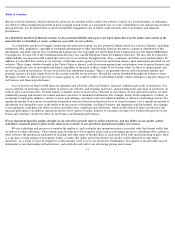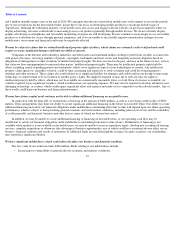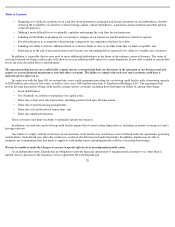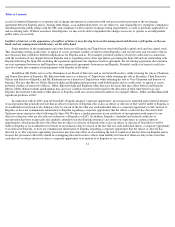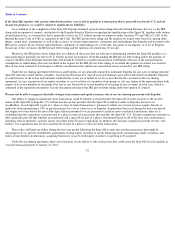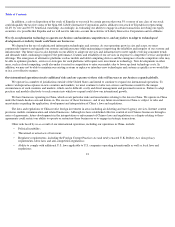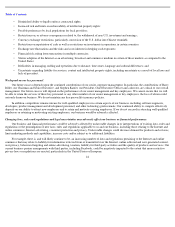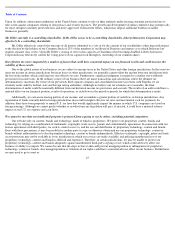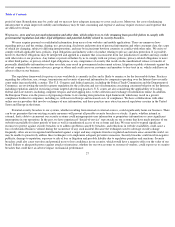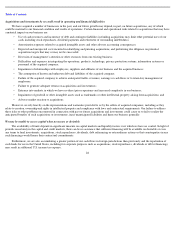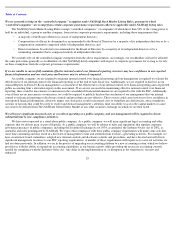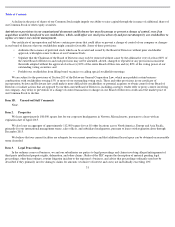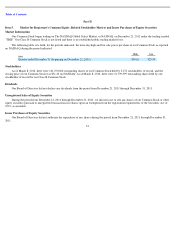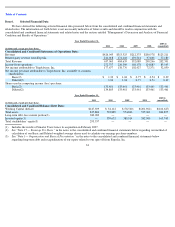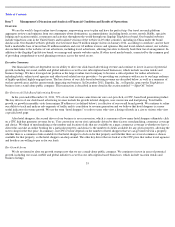TripAdvisor 2011 Annual Report Download - page 30
Download and view the complete annual report
Please find page 30 of the 2011 TripAdvisor annual report below. You can navigate through the pages in the report by either clicking on the pages listed below, or by using the keyword search tool below to find specific information within the annual report.
Table of Contents
other tribunals to enforce our intellectual property rights, to protect our trade secrets or to determine the validity and scope of the proprietary
rights of others. These proceedings might result in substantial costs and diversion of resources and management attention. Our failure to protect
our intellectual property in a cost-effective or effective manner could have a material adverse effect on our business and ability to protect our
technology, content and brands.
We currently license from third parties, and from Expedia, some of the technologies, content and brands incorporated into our websites. As
we continue to introduce new services that incorporate new technologies, content and brands, we may be required to license additional
technology, content or brands. We cannot be sure that such technology, content and brand licenses will be available on commercially reasonable
terms, if at all.
We are subject to foreign exchange risk.
We conduct a significant and growing portion of our business outside the United States. As a result, we face exposure to movements in
currency exchange rates, particularly those related to the euro, British pound sterling, Canadian dollar, Australian dollar, Singapore dollar and
Chinese renminbi.
These exposures include, but are not limited to re-measurement gains and losses from changes in the value of foreign denominated assets
and liabilities; translation gains and losses on foreign subsidiary financial results that are translated into U.S. dollars upon consolidation; and
planning risk related to changes in exchange rates between the time we prepare our annual and quarterly forecasts and when actual results occur.
Depending on the size of the exposures and the relative movements of exchange rates, if we were to choose not to hedge or were to fail to
hedge effectively our exposure, we could experience a material adverse effect on our financial statements and financial condition. As seen in
some recent periods, in the event of severe volatility in exchange rates the impact of these exposures can increase, and the impact on results of
operations can be more pronounced. In addition, the current environment and the increasingly global nature of our business have made hedging
these exposures both more complex and costly. Historically, we have not hedged translation risks as cash flows from its international operations
were generally reinvested locally; therefore we could incur unanticipated translation gains and losses.
System interruption and the lack of redundancy in some of our internal information systems may harm our business.
We rely on computer systems to deliver content and services. We have experienced and may in the future experience system interruptions
that make some or all of these systems unavailable or prevent us from efficiently fulfilling orders or providing content and services to users and
third parties. Significant interruptions, outages or delays in internal systems, or systems of third parties that we rely upon including multiple co-
location providers for data centers and network access, or deterioration in the performance of any such systems, would impair our ability to
process transactions or display content and decrease the quality of the services we offer to travelers and users. These interruptions could include
security intrusions and attacks on our systems for fraud or service interruption (called “denial of service” or “bot” attacks). If we were to
experience frequent or persistent system failures, our business, reputations and brand could be harmed.
In addition, we lack backup systems or contingency plans for certain critical aspects of our operations or business processes. Many other
systems are not fully redundant and their disaster recovery or business continuity planning may not be sufficient. Fire, flood, power loss,
telecommunications failure, break-ins, earthquakes, acts of war or terrorism, acts of God, computer viruses, electronic intrusion attempts from
both external and internal sources and similar events or disruptions may damage or impact or interrupt computer or communications systems or
business processes at any time. Although we have put measures in place to protect certain portions of our facilities and assets, any of these
events could cause system interruption, delays and loss of critical data, and could prevent us from providing content and services to users,
travelers and/or third parties for a significant
26



